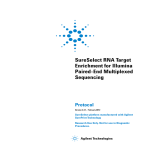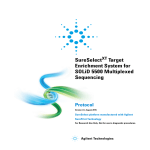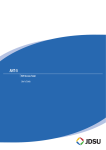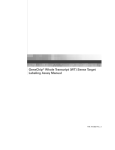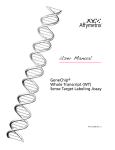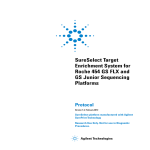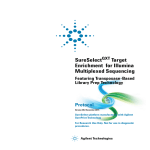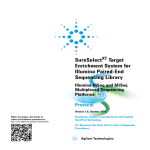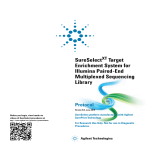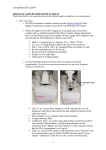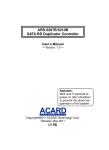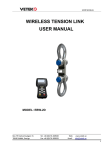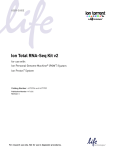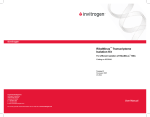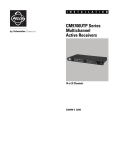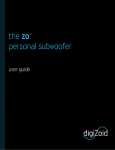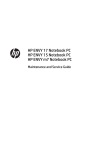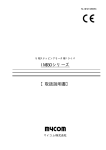Download SureSelect RNA Capture Enrichment System for SOLiD Multiplexed
Transcript
SureSelect RNA Capture Enrichment System for SOLiD Multiplexed Sequencing Protocol Version 1.2, February 2012 SureSelect platform manufactured with Agilent SurePrint Technology Research Use Only. Not for use in Diagnostic Procedures. Agilent Technologies Notices © Agilent Technologies, Inc. 2011-2012 Warranty No part of this manual may be reproduced in any form or by any means (including electronic storage and retrieval or translation into a foreign language) without prior agreement and written consent from Agilent Technologies, Inc. as governed by United States and international copyright laws. Oligonucleotide sequences © 2006 and 2008 Applied Biosystems, a division of Life Technologies, Inc. All rights reserved. Only for use with the Applied Biosystems SOLiD System Sequencing and associated assays. The material contained in this document is provided “as is,” and is subject to being changed, without notice, in future editions. Further, to the maximum extent permitted by applicable law, Agilent disclaims all warranties, either express or implied, with regard to this manual and any information contained herein, including but not limited to the implied warranties of merchantability and fitness for a particular purpose. Agilent shall not be liable for errors or for incidental or consequential damages in connection with the furnishing, use, or performance of this document or of any information contained herein. Should Agilent and the user have a separate written agreement with warranty terms covering the material in this document that conflict with these terms, the warranty terms in the separate agreement shall control. Technical Support Technology Licenses For technical product support, contact your local Agilent Support Services representative. The hardware and/or software described in this document are furnished under a license and may be used or copied only in accordance with the terms of such license. Manual Part Number G7580-90011 Edition Version 1.2, February 2012 Printed in USA Agilent Technologies, Inc. 5301 Stevens Creek Rd Santa Clara, CA 95051 USA Acknowledgement For US and Canada, call (800) 227-9770 (option 3,4,4). For other countries, find your support center telephone numbers at www.agilent.com/chem/contactus. Or send an e-mail to: [email protected] Notice to Purchaser Research Use Only. Not for use in diagnostic procedures. 2 Restricted Rights Legend Safety Notices CAUTION A CAUTION notice denotes a hazard. It calls attention to an operating procedure, practice, or the like that, if not correctly performed or adhered to, could result in damage to the product or loss of important data. Do not proceed beyond a CAUTION notice until the indicated conditions are fully understood and met. WA R N I N G A WARNING notice denotes a hazard. It calls attention to an operating procedure, practice, or the like that, if not correctly performed or adhered to, could result in personal injury or death. Do not proceed beyond a WARNING notice until the indicated conditions are fully understood and met. U.S. Government Restricted Rights. Software and technical data rights granted to the federal government include only those rights customarily provided to end user customers. Agilent provides this customary commercial license in Software and technical data pursuant to FAR 12.211 (Technical Data) and 12.212 (Computer Software) and, for the Department of Defense, DFARS 252.227-7015 (Technical Data - Commercial Items) and DFARS 227.7202-3 (Rights in Commercial Computer Software or Computer Software Documentation). SureSelect RNA Capture Enrichment for AB SOLiD Multiplexed Sequencing In this Guide... This guide describes the recommended operational procedures to capture transcripts of interest using the Agilent SureSelect RNA Capture Kits, and sample preparation kits for next-generation sequencing. This protocol is specifically developed and optimized to use Biotinylated RNA oligomer libraries, or Bait, to enrich targeted regions of the transcriptome. This guide uses the Life Technologies SOLiD System for library preparation. 1 Before You Begin This chapter contains information (such as procedural notes, safety information, required reagents and equipment) that you should read and understand before you start an experiment. 2 Sample Preparation This chapter contains instructions for prepped library production specific to the Life Technologies SOLiD System. 3 Hybridization This chapter describes the steps to combine the prepped library with the blocking agents and the SureSelect capture library. 4 Addition of Barcode Tags by Post-Hybridization Amplification This chapter describes the steps to amplify, purify, and quantify the sample library after target enrichment hybridization. 5 Reference This chapter contains reference information. SureSelect RNA Capture Enrichment for AB SOLiD Multiplexed Sequencing 3 What’s New in 1.2 • New product configuration and product numbers for SureSelect reagent kits and capture libraries. • Support for the optional use of the Agilent 2200 TapeStation for RNA quantitation and qualification. • Support for custom SureSelect RNA capture libraries. • The volume of barcode library to use for one reaction is clarified. What’s New in 1.1 • Reagent cap colors are listed where available. • More details given for the reagent kits to use for each step. • More details given to fragment the RNA. • Update to solution storage information for some stopping points. 4 SureSelect RNA Capture Enrichment for AB SOLiD Multiplexed Sequencing Content 1 Before You Begin 7 Procedural Notes 8 Safety Notes 8 Required Reagents 9 Required Equipment 11 Optional Equipment 13 2 Sample Preparation 15 Step 1. Fragment the RNA 18 Step 2. Purify the RNA with the Ribominus Concentration Module 20 Step 3. Quantitate and assess size distribution 22 Step 4. Hybridize and ligate the RNA 24 Step 5. Reverse transcription 26 Step 6. Purify the cDNA 28 Step 7. Size-select the DNA fragments with a E-Gel SizeSelect 2% Agarose gel 29 Step 8. Purify the size-selected cDNA 31 Step 9. Amplify the cDNA 33 Step 10. Purify the amplified DNA 35 Step 11. Quantify the Library with the 2100 Bioanalyzer DNA 1000 assay 37 3 Hybridization 39 Step 1. Hybridize the library 42 Step 2. Prepare magnetic beads 48 Step 3. Select hybrid capture with SureSelect 49 Step 4. Purify the sample using Agencourt AMPure XP beads SureSelect RNA Capture Enrichment for AB SOLiD Multiplexed Sequencing 51 5 Contents 4 Addition of Barcode Tags by Post-Hybridization Amplification 53 Step 1. Amplify the captured library to add barcode tags 54 Step 2. Purify the sample using Agencourt AMPure XP beads 57 Step 3. Assess quality with the 2100 Bioanalyzer High Sensitivity DNA assay 58 Step 4. Assess the quantity of each barcode-tagged library by QPCR 61 Step 5. Pool samples for Multiplexed Sequencing 62 Step 6. Do an emulsion PCR 63 5 Reference 65 SureSelect Reagent Kit Content 66 Other Reagent Kits Content 68 SureSelectXT Barcodes for SOLiD 71 Alternative Capture Equipment Combinations 6 72 SureSelect RNA Capture Enrichment for AB SOLiD Multiplexed Sequencing SureSelect RNA Capture Enrichment System for SOLiD Multiplexed Sequencing Protocol 1 Before You Begin Procedural Notes 8 Safety Notes 8 Required Reagents 9 Required Equipment 11 Optional Equipment 13 Make sure you have the most current protocol. Go to the SureSelect Related Literature page on genomics.agilent.com and search for manual number G7580-90011. Make sure you read and understand the information in this chapter and have the necessary equipment and reagents listed before you start an experiment. NOTE Agilent cannot guarantee the SureSelect Target Enrichment kits and cannot provide technical support for the use of non-Agilent protocols to process samples for enrichment. Agilent Technologies 7 1 Before You Begin Procedural Notes Procedural Notes • Prolonged exposure of SureSelect Elution Buffer to air can decrease product performance by altering the pH of the solution. Keep the Elution Buffer container tightly sealed when not in use. • To prevent contamination of reagents by nucleases, always wear powder-free laboratory gloves and use dedicated solutions and pipettors with nuclease-free aerosol-resistant tips. • Maintain a clean work area. • Do not mix stock solutions and reactions containing RNA on a vortex mixer. Instead, gently tap the tube with your finger to mix the sample. • Avoid repeated freeze-thaw cycles of stock and diluted RNA solutions. • When preparing frozen reagent stock solutions for use: 1 Thaw the aliquot as rapidly as possible without heating above room temperature. 2 Mix briefly on a vortex mixer, then spin in a centrifuge for 5 to 10 seconds to drive the contents off of walls and lid. 3 Store on ice or in a cold block until use. • In general, follow Biosafety Level 1 (BL1) safety rules. Safety Notes CAUTION 8 Wear appropriate personal protective equipment (PPE) when working in the laboratory. SureSelect RNA Capture Enrichment for AB SOLiD Multiplexed Sequencing Before You Begin Required Reagents 1 Required Reagents Table 1 Required Reagents for Library Prep and Post-Hybridization Amplification Description Vendor and part number DNA 1000 Kit Agilent p/n 5067-1504 RNA 6000 Pico Kit Agilent p/n 5067-1513 High Sensitivity DNA Kit Agilent p/n 5067-4626 Herculase II Fusion DNA Polymerase (includes dNTP mix and 5x Buffer) 200 reactions 400 reactions Agilent p/n 600677 p/n 600679 (Each library requires 4 reactions for pre-capture amplification and 2 reactions for post-capture amplification.) Nuclease-free Water (not DEPC-treated) Ambion Cat #AM9930 Agencourt AMPure XP Kit 5 mL 60 mL 450 mL Beckman Coulter Genomics p/n A63880 p/n A63881 p/n A63882 SOLiD Total RNA-Seq Kit Life Technologies p/n 4445374 1X Low TE Buffer (10 mM Tris-HCl, pH 8.0, 0.1 mM EDTA) Life Technologies p/n 4389764 E-Gel SizeSelect 2% Agarose Gel Life Technologies p/n G6610-02 50-bp ladder Life Technologies p/n 10416-014 PureLink PCR Micro Kit Life Technologies p/n K3100-50 Ribominus Concentration Module (6 preps) Life Technologies p/n K1550-05 MinElute PCR Purification Kit (50) Qiagen p/n 28004 100% Ethanol, molecular biology grade Sigma-Aldrich p/n E7023 SureSelect RNA Capture Enrichment for AB SOLiD Multiplexed Sequencing 9 1 Before You Begin Required Reagents Table 2 SureSelect Reagent Kit Reagent Kits 16 Reactions 96 Reactions 480 Reactions SureSelect TE RNA Reagent Kit, S4 G9604A G9604B G9604C Table 3 SureSelect Capture Library (select one) Capture Libraries 16 Reactions 96 Reactions 480 Reactions SureSelect RNA Kinome 5190-4801 5190-4802 5190-4803 SureSelect RNA Capture 1 kb up to 499 Kb 5190-4934 5190-4935 5190-4937 (reorder) 5190-4939 5190-4940 5190-4942 SureSelect RNA Capture 0.5 Mb up to 2.9 Mb 5190-4944 5190-4945 5190-4947 (reorder) 5190-4949 5190-4950 5190-4952 SureSelect RNA Capture 3 Mb up to 5.9 Mb 5190-4954 5190-4955 5190-4957 (reorder) 5190-4959 5190-4960 5190-4962 Table 4 Required Reagents for Hybridization Description Vendor and part number Dynabeads MyOne Streptavidin T1 Life Technologies 2 mL 10 mL 100 mL Cat #65601 Cat #65602 Cat #65603 Nuclease-free Water (not DEPC-treated) 10 Ambion Cat #AM9930 SureSelect RNA Capture Enrichment for AB SOLiD Multiplexed Sequencing Before You Begin Required Equipment 1 Required Equipment Table 5 Required Equipment for Library Prep and Post-Hybridization Amplification Description Vendor and part number 2100 Bioanalyzer Agilent p/n G2938C Thermal cycler Agilent SureCycler, Life Technologies Veriti Thermal Cycler, BioRad (MJ Research) DNA Engine PTC-200, or equivalent Eppendorf Microcentrifuge Model 5417R Eppendorf p/n 022621807 (120 V/60 Hz), Eppendorf p/n 022621840 (230 V/50 Hz) or equivalent Eppendorf fixed-angle rotor with standard lid Eppendorf p/n 022636006 DNA LoBind Tubes, 1.5-mL PCR clean, 250 pieces Eppendorf p/n 022431021 or equivalent E-Gel iBase and E-Gel Safe Imager Combo Kit Life Technologies p/n G6465 P10, P20, P200 and P1000 pipettes Pipetman P10, P20, P200, P1000 or equivalent Vacuum concentrator Savant SpeedVac or equivalent Ice bucket Powder-free gloves PCR plates PCR strip caps or equivalent Sterile, nuclease-free aerosol barrier pipette tips Timer Vortex mixer Heat block at 37°C SureSelect RNA Capture Enrichment for AB SOLiD Multiplexed Sequencing 11 1 Before You Begin Required Equipment Table 6 Required Equipment for Hybridization Description Vendor and part number Mx3000P/Mx3005P 96-well tube plates Agilent p/n 410088 or equivalent Mx3000P/Mx3005P optical strip caps Agilent p/n 401425 or equivalent MicroAmp Clear Adhesive Film Life Technologies p/n 4306311 or equivalent BD Clay Adams Nutator Mixer BD Diagnostics p/n 421105 or equivalent Dynal DynaMag-2 magnetic stand Life Technologies p/n 123-21D or equivalent P10, P20, P200 and P1000 pipettes Pipetman P10, P20, P200, P1000 or equivalent Pipet-Light Multichannel Pipette, 12 channels Rainin p/n L12-20 or equivalent PCR plates PCR strip caps or equivalent Sterile, nuclease-free aerosol barrier pipette tips Thermal cycler Agilent SureCycler, Life Technologies Veriti Thermal Cycler, BioRad (MJ Research) DNA Engine PTC-200, or equivalent Timer Vortex mixer Water bath or heat block set to 65°C 12 SureSelect RNA Capture Enrichment for AB SOLiD Multiplexed Sequencing Before You Begin Optional Equipment 1 Optional Equipment Table 7 Optional Equipment for Hybridization Description Vendor and part number Tube-strip capping tool Agilent p/n 410099 Table 8 Optional Equipment for Library Prep and Post-Hybridization Amplification Description Vendor and part number 2200 TapeStation System Agilent p/n G2964AA or G2965AA D1K ScreenTape Agilent p/n 5067-5361 D1K Reagents Agilent p/n 5067-5362 SureSelect RNA Capture Enrichment for AB SOLiD Multiplexed Sequencing 13 1 14 Before You Begin Optional Equipment SureSelect RNA Capture Enrichment for AB SOLiD Multiplexed Sequencing SureSelect RNA Capture Enrichment System for SOLiD Multiplexed Sequencing Protocol 2 Sample Preparation Step 1. Fragment the RNA 18 Step 2. Purify the RNA with the Ribominus Concentration Module 20 Step 3. Quantitate and assess size distribution 22 Step 4. Hybridize and ligate the RNA 24 Step 5. Reverse transcription 26 Step 6. Purify the cDNA 28 Step 7. Size-select the DNA fragments with a E-Gel SizeSelect 2% Agarose gel 29 Step 8. Purify the size-selected cDNA 31 Step 9. Amplify the cDNA 33 Step 10. Purify the amplified DNA 35 Step 11. Quantify the Library with the 2100 Bioanalyzer DNA 1000 assay 37 This chapter contains instructions for prepped library production specific to the Applied Biosystems SOLiD System. Agilent Technologies 15 2 Sample Preparation polyA RNA or rRNA-depleted total RNA Fragment the RNA Fragmented RNA Hybridize and Ligate Ligated RNA Reverse Transcription cDNA Genomic Locations Size-select the DNA Bait Design in eArray Correctly sized ligation products SureSelect Capture Library PCR amplify Prepped Library Library Hybridization 24 hours at 65°C Hybrid Capture Selection Magnetic bead selection PCR Amplification Purification Quality Assessment Sequencing Figure 1 16 Overall sequencing sample preparation workflow. SureSelect RNA Capture Enrichment for AB SOLiD Multiplexed Sequencing Sample Preparation Table 9 2 Overview and time requirements Step Time AB SOLiD Fragment Library Production 2 days Library Hybridization 25 hours (optional 72 hours) Bead preparation 30 minutes Capture Selection and Washing 2 hours DNA Purification 30 minutes Post-Hybridization Amplification 1 hour PCR Purification 30 minutes Bioanalyzer QC 1 hour SureSelect RNA Capture Enrichment for AB SOLiD Multiplexed Sequencing 17 2 Sample Preparation Step 1. Fragment the RNA Step 1. Fragment the RNA Use the SOLiD Total RNA-Seq Kit (Life Technologies p/n 4445374). 1 Prepare your RNA sample. For poly(A) RNA: • Do two rounds of oligo(dT) selection of the poly(A) RNA. For example, use the Applied Biosystems MicroPoly(A)Purist™ Kit. • Confirm the absence of 18S and 28S rRNA. For example, check the profile of the poly(A) RNA on an Agilent 2100 Bioanalyzer. For rRNA-depleted total RNA: • Remove rRNA from total RNA for transcriptome analysis. Use the Invitrogen RiboMinus Eukaryote Kit for RNA-Seq or the Invitrogen RiboMinus Plant Kit for RNA-Seq. Use only high-quality RNA as your starting material. FirstChoice Total RNA and Poly(A) RNA provide high-quality, intact RNA isolated from a variety of sources. 2 For each RNA reaction, mix the components on ice. Table 10 Fragmentation Mix Component Volume RNA Sample: Poly(A) RNA: 100 to 500 ng or 100 ng to 500 ng rRNA-depleted total RNA 250 to 500 ng WT Control RNA 0.5 µL Nuclease-free water Enough to complete 8 µL total with RNA sample and WT Control RNA 10X RNase III Buffer 1 µL RNase III 1 µL Total 10 µL 3 Gently tap the tube, or pipette the mix up and down to mix, then spin briefly. 18 SureSelect RNA Capture Enrichment for AB SOLiD Multiplexed Sequencing Sample Preparation Step 1. Fragment the RNA 2 4 Incubate the reaction in a preheated PCR thermal cycler at 37°C for 10 minutes. 5 Immediately add 90 µL of nuclease-free water, then put the fragmented RNA on ice. Continue to the next step immediately, or leave the fragmented RNA on ice for one hour or less. SureSelect RNA Capture Enrichment for AB SOLiD Multiplexed Sequencing 19 2 Sample Preparation Step 2. Purify the RNA with the Ribominus Concentration Module Step 2. Purify the RNA with the Ribominus Concentration Module Use reagents from the RiboMinus Concentration Module (Life Technologies p/n K1550-05): • Wash Buffer (W5) • Binding Buffer (L3) • RNase-Free Water 1 Mix the components in Table 11 to prepare the Wash Buffer (W5), then store at room temperature. Table 11 Wash Buffer Mix Component Volume 100% ethanol 6 mL Wash Buffer (W5) 1.5 mL Total 7.5 mL 2 Add the components in Table 12 to the fragmented RNA and mix. Table 12 Component Volume Binding Buffer (L3) 100 µL 100% ethanol 250 µL 3 Put the spin column in a clean 1.5-mL wash tube. 4 Put 450 µL of the RNA sample that contains Binding Buffer (L3) and ethanol onto the spin column. 5 Spin the column in a centrifuge at 12,000 × g for 1 minute. 6 Discard the flow-through. 7 Return the spin column to the same wash tube. 20 SureSelect RNA Capture Enrichment for AB SOLiD Multiplexed Sequencing Sample Preparation Step 2. Purify the RNA with the Ribominus Concentration Module 2 8 Add 500 µL of Wash Buffer (W5) with ethanol to the spin column. 9 Spin the column in a centrifuge at 12,000 × g for 1 minute. 10 Discard the flow-through. 11 Return the spin column to the same wash tube. 12 Spin the column in a centrifuge at 20,000 × g or higher for 2 minutes. 13 Put the spin column in a clean recovery tube. 14 Add 12 µL of the RNase-Free Water to the center of the spin column. 15 Wait 1 minute, then spin the column at 20,000 × g or higher for 1 minute. Typical recovery of fragmented RNA is approximately 10 µL. SureSelect RNA Capture Enrichment for AB SOLiD Multiplexed Sequencing 21 2 Sample Preparation Step 3. Quantitate and assess size distribution Step 3. Quantitate and assess size distribution Use the Quant-iT RNA Assay Kit with the Qubit Fluorometer (Invitrogen) and the RNA 6000 Pico Chip Kit with the 2100 Bioanalyzer. 1 Quantitate the yield of fragmented RNA using the Quant-it RNA Assay Kit with the Qubit Fluorometer or a Nanodrop Spectrophotometer 2 Dilute 1 µL of the sample 1:10 with nuclease-free water. 3 Open the Agilent 2100 Expert Software (version B.02.07 or higher), turn on the 2100 Bioanalyzer and check communication. 4 Prepare the chip, samples and ladder as instructed in the reagent kit guide. 5 Load the prepared chip into the 2100 Bioanalyzer and start the run within five minutes after preparation. 6 Within the instrument context, choose the appropriate assay from the drop down list. 7 Start the run. Enter sample names and comments in the Data and Assay context. 8 Verify the results. Check that the electropherogram shows a distribution with a peak size around 100 to 200 nt. 9 If the amount of fragmented RNA in 3 µL is: • <50 ng poly (A) RNA • <250 ng rRNA-depleted total RNA then: a Dry 50 to 250 ng of the RNA completely in a centrifugal vacuum concentrator at low or medium heat (<=40°C). This process takes 10 to 20 minutes. b Resuspend in 3 µL nuclease-free water. See Figure 2 for typical results of fragmentation of whole transcriptome RNA. 22 SureSelect RNA Capture Enrichment for AB SOLiD Multiplexed Sequencing Sample Preparation Step 3. Quantitate and assess size distribution Figure 2 2 Size distribution of fragmented rRNA-depleted total RNA SureSelect RNA Capture Enrichment for AB SOLiD Multiplexed Sequencing 23 2 Sample Preparation Step 4. Hybridize and ligate the RNA Step 4. Hybridize and ligate the RNA Use the SOLiD Total RNA-Seq Kit (Life Technologies p/n 4445374). • SOLiD Adaptor Mix • Hybridization Solution • Nuclease-free Water • 2X Ligation Buffer • Ligation Enzyme Mix 1 Prepare the Hybridization Master Mix in Table 13 on ice. Table 13 Hybridization Master Mix Component Volume per reaction* SOLiD Adaptor Mix 2 µL Hybridization Solution 3 µL Total volume per reaction 5 µL * To prepare for multiple samples, include 5% to 10% excess volume. 2 Transfer 5 µL hybridization master mix to 3 µL fragmented RNA sample: • Fragmented poly(A) RNA: 50 ng • Fragmented rRNA-depleted total RNA: up to 250 ng • Fragmented WT Control RNA: 100 ng 3 Slowly pipet up and down a few times to mix well, then spin briefly. 4 Run the hybridization reaction in a thermal cycler: Table 14 24 PCR program Temperature Time 65°C 10 minutes 16°C 5 minutes SureSelect RNA Capture Enrichment for AB SOLiD Multiplexed Sequencing Sample Preparation Step 4. Hybridize and ligate the RNA 2 5 Add the RNA ligation reagents to each 8-µL hybridization reaction in the order listed in Table 15: Table 15 NOTE RNA ligation reagents Component Volume 2X Ligation Buffer 10 µL Ligation Enzyme Mix 2 µL If you see white precipitate in the 2X Ligation Buffer, warm the tube at 37°C for 2 to 5 minutes or until the precipitate is dissolved. 2X Ligation Buffer is very viscous. Pipette slowly to dispense it accurately. 6 Flick the tube, or slowly pipet up and down a few times, to mix well, then spin briefly. 7 Incubate the 20-µL ligation reaction in a thermal cycler at 16 °C for 16 hours. If possible, set the temperature of the thermal cycler lid to match the block temperature. Otherwise, incubate the reaction with the heated lid turned off, or do not cover the reaction tubes with the heated lid. SureSelect RNA Capture Enrichment for AB SOLiD Multiplexed Sequencing 25 2 Sample Preparation Step 5. Reverse transcription Step 5. Reverse transcription Use the SOLiD Total RNA-Seq Kit (Life Technologies p/n 4445374). • Nuclease-free Water • 10X RT Buffer • dNTP Mix • SOLiD RT Primer • ArrayScript Reverse Transcriptase 1 Prepare RT Master Mix in Table 16. Do not add the ArrayScript Reverse Transcriptase at this time. Table 16 RT Master Mix Component Volume per reaction* Nuclease-free Water 11 µL 10X RT Buffer 4 µL dNTP Mix 2 µL SOLiD RT Primer 2 µL Total volume per reaction 19 µL * To prepare for multiple samples, include 5% to 10% excess volume. 2 Incubate the RT master mix with the ligated RNA sample: a Add 19 µL of RT master mix to each 20-µL ligation reaction. b Pipette up and down a few times to mix, then spin briefly. c Incubate in a thermal cycler with a heated lid at 70 °C for 5 minutes, then snap-cool on ice. 26 SureSelect RNA Capture Enrichment for AB SOLiD Multiplexed Sequencing Sample Preparation Step 5. Reverse transcription 2 3 Do the reverse transcription reaction: a Add 1 µL ArrayScript Reverse Transcriptase to each ligated RNA sample. b Mix gently but thoroughly on a vortex mixer, then spin briefly. c Incubate in a thermal cycler with a heated lid at 42 °C for 30 minutes. If not used immediately, store the cDNA at -20 °C for up to a few weeks, or -80°C long-term. SureSelect RNA Capture Enrichment for AB SOLiD Multiplexed Sequencing 27 2 Sample Preparation Step 6. Purify the cDNA Step 6. Purify the cDNA Use the MinElute PCR Purification Kit (Qiagen p/n 28004 or 28006): • Buffer PBI • MinElute Spin Column • Buffer PE • Buffer EB 1 Add nuclease-free water and Buffer PBI to the cDNA: a Transfer all of the cDNA (40 µL) to a clean 1.5-mL microcentrifuge tube. b Add 60 µL of nuclease-free water. c Add 500 µL of Buffer PBI, then mix well. You do not need to add pH Indicator to Buffer PBI before use. 2 Load the cDNA onto the MinElute Spin Column: a Load 600 µL of the sample containing Buffer PBI onto the MinElute column. b Spin the column at 13,000 × g for 1 minute. c Discard the supernatant. 3 Wash the cDNA: a Return the MinElute Spin Column to the microcentrifuge tube. b Add 750 µL of Buffer PE to the MinElute Spin Column. c Spin the column at 13,000 × g for 1 minute. d Discard the supernatant. e Return the MinElute Spin Column to the microcentrifuge tube. f Spin the column at 13,000 × g for 1 minute. 4 Elute the cDNA in a clean microcentrifuge tube: a Place the MinElute Spin Column in a clean microcentrifuge tube. b Add 20 µL of Buffer EB to the center of the MinElute Spin Column. c Wait 1 minute, then spin the column at 13,000 × g for 1 minute. 28 SureSelect RNA Capture Enrichment for AB SOLiD Multiplexed Sequencing Sample Preparation Step 7. Size-select the DNA fragments with a E-Gel SizeSelect 2% Agarose gel 2 Step 7. Size-select the DNA fragments with a E-Gel SizeSelect 2% Agarose gel Use the E-Gel SizeSelect 2% Agarose gel (Invitrogen p/n G6610-02). 1 Remove a E-Gel SizeSelect 2% Agarose gel from its package. Remove the combs from the top sample-loading wells and the middle collection wells. Set the E-Gel on the E-Gel iBase linked with the E-Gel Safe Imager. 2 Load the E-Gel as follows: a Load 20 µL of the ligated, purified DNA into a well in the top row. Do not use the center well or outermost wells (to avoid edge effects). Do not load more than 1 µg of DNA. If the sample volume < 20 µL, add nuclease-free water to the well for a total volume of 20 µL. b Load 2 µL 50-bp ladder at 0.1 µg/µL to the center top well. Add 15 µL of water to fill the well. c Fill empty wells in the top row with 20 µL of nuclease-free water. d Fill each of the collection wells in the middle of the gel with 25 µL of nuclease-free water. Add 20 µL of nuclease-free water to the middle center well. 3 Run the gel: • iBase program: Run E-Gel DC • Approximate run time: 13:45 (13 minutes and 45 seconds) Monitor the E-Gel in real-time with the E-Gel® Safe Imager. 4 If needed during the run, fill the middle collection wells with nuclease-free water. 5 When the 200-bp band from the marker lane is in the center of the collection well, stop the run if the run has not already stopped (see Figure 3). 6 Collect the solution from the sample well. 7 Wash each collection well with 25 µL of nuclease-free water, pipette up and down, then retrieve the wash solution and combine with the respective sample solution collected in step 6 for a total of 50 µL. See Table 17 for expected lengths of the insert and PCR according to the excised cDNA length. SureSelect RNA Capture Enrichment for AB SOLiD Multiplexed Sequencing 29 2 30 Sample Preparation Step 7. Size-select the DNA fragments with a E-Gel SizeSelect 2% Agarose gel Figure 3 Elution of an approximately 200 bp region from SOLiD Library Size Selection gel. This image shows three samples on the same gel. Table 17 Expected lengths of the insert and PCR according to the excised cDNA length Excised cDNA length (nt) Insert length (bp) PCR product length (bp) 50 ~0 ~100 100 ~50 ~150 150 ~100 ~200 200 ~150 ~250 250 ~200 ~300 SureSelect RNA Capture Enrichment for AB SOLiD Multiplexed Sequencing Sample Preparation Step 8. Purify the size-selected cDNA 2 Step 8. Purify the size-selected cDNA Use the PureLink PCR Micro Kit (Life Technologies p/n K3100-01): • PureLink PCR Spin Column • PureLink PCR Collection Tube • Binding Buffer (B2) • Wash Buffer (W1) • PureLink Elution Tube • Elution Buffer; 10 mM Tris-HCl, pH 8.5 (E1) CAUTION Do not use other PCR purification kits. Other purification kits are not as effective in the removal of unincorporated primers. Unincorporated primers can affect the final quantitation and emulsion PCR. 1 Prepare the sample: a Add 50 µL of nuclease-free water to the sample for a total of approximately 100 µL. b Add 400 µL of Binding Buffer (B2) to the tube, then mix well. 2 Load the sample onto the PureLink PCR Spin Column: a Place the PureLink PCR Spin Column in a clean collection tube. b Load 500 µL of the sample containing Binding Buffer (B2) onto the column. c Spin the column at 10,000 × g for 1 minute. d Discard the supernatant. 3 Wash the DNA: a Return the column to the collection tube. b Add 600 µL of Wash Buffer (W1) to the column. c Spin the column at 10,000 × g for 1 minute. d Discard the supernatant. e Return the column to the collection tube. f Spin the column at 14,000 × g for 1 minute. SureSelect RNA Capture Enrichment for AB SOLiD Multiplexed Sequencing 31 2 Sample Preparation Step 8. Purify the size-selected cDNA 4 Elute the DNA in a clean PureLink PCR Spin Column: a Place the column in a clean PureLink PCR Spin Column. b Add 10 µL of Elution Buffer; 10 mM Tris-HCl, pH 8.5 (E1) to the center of the membrane. c Wait 1 minute, then spin the column at 14,000 × g for 1 minute. 32 SureSelect RNA Capture Enrichment for AB SOLiD Multiplexed Sequencing Sample Preparation Step 9. Amplify the cDNA 2 Step 9. Amplify the cDNA Use the SOLiD Total RNA-Seq Kit (Life Technologies p/n 4445374). • Nuclease-free Water • 10X PCR Buffer • dNTP Mix • SOLiD 5' PCR Primer • SOLiD 3' PCR Primer • AmpliTaq DNA Polymerase 1 For each cDNA sample, prepare duplicate amplification reactions to generate sufficient cDNA for enrichment: . Table 18 PCR Mix Component Volume for one 100-µL reaction Volume for two 100-µL reaction* Nuclease-free Water 74.8 µL 164.6 µL 10X PCR Buffer 10.0 µL 22.0 µL dNTP Mix 8.0 µL 17.6 µL SureSelect XT S4 Pre Capture Primer (green cap)† 4.0 µL 8.8 µL AmpliTaq DNA Polymerase 1.2 µL 2.6 µL Total volume per reaction 98.0 µL 215.6 µL * To prepare for multiple samples, include 5% to 10% excess volume. † Included in the SureSelect LT Barcoding Lib. Kit d Transfer 98 µL PCR mix into each 0.2-mL PCR tube. e Add 2 µL of cDNA and mix thoroughly. 2 Run the PCR reactions in a thermal cycler as listed in Table 19. SureSelect RNA Capture Enrichment for AB SOLiD Multiplexed Sequencing 33 2 Sample Preparation Step 9. Amplify the cDNA Table 19 PCR Program Step Temp Time Hold 95 °C 5 minutes Cycle (15 cycles) 95 °C 30 seconds 54 °C 30 seconds 72 °C 30 seconds 72 °C 7 minutes Hold Run 15 cycles if you start with 50 to 100 ng of fragmented RNA. If needed, adjust the number of cycles according to the amount of input fragmented RNA, but for optimal results run between 12 and 18 cycles. Too many cycles results in overamplification and changes the expression profile. 34 SureSelect RNA Capture Enrichment for AB SOLiD Multiplexed Sequencing Sample Preparation Step 10. Purify the amplified DNA 2 Step 10. Purify the amplified DNA Use the PureLink PCR Micro Kit (Life Technologies p/n K3100-50): • Binding Buffer (B2) • Wash Buffer (W1) • Elution Buffer (E5) (10 mM Tris-HCl, pH 8.5) • PureLink Micro Kit Column • PureLink Elution Tube • Collection Tube CAUTION Do not use other PCR purification kits. Other purification kits are not as effective in the removal of unincorporated primers. Unincorporated primers can affect the final quantitation and emulsion PCR. 1 Prepare the sample: a Combine the two 100-µL PCR reactions in a new 1.5-mL tube. b Add 800 µL of Binding Buffer (B2) to the tube, then mix well. 2 Load the sample onto the PureLink Micro Kit Column: a Place the PureLink Micro Kit Column in a clean collection tube. b Load 500 µL of the sample containing Binding Buffer (B2) onto the column. c Spin the column at 10,000 × g for 1 minute. d Discard the supernatant. e Load the remaining 500 µL of the sample containing Binding Buffer (B2) onto the column. f Spin the column at 10,000 × g for 1 minute. g Discard the supernatant. SureSelect RNA Capture Enrichment for AB SOLiD Multiplexed Sequencing 35 2 Sample Preparation Step 10. Purify the amplified DNA 3 Wash the DNA: a Return the column to the collection tube. b Add 600 µL of Wash Buffer (W1) to the column. c Spin the column at 10,000 × g for 1 minute. d Discard the supernatant. e Return the column to the collection tube. f Spin the column at 14,000 × g for 1 minute. 4 Elute the DNA in a clean PureLink Elution Tube: a Place the column in a clean PureLink Elution Tube. b Add 10 µL of Elution Buffer (E5) (10 mM Tris-HCl, pH 8.5) to the center of the membrane. c Wait 1 minute, then spin the column at 14,000 × g for 1 minute. 36 SureSelect RNA Capture Enrichment for AB SOLiD Multiplexed Sequencing Sample Preparation Step 11. Quantify the Library with the 2100 Bioanalyzer DNA 1000 assay 2 Step 11. Quantify the Library with the 2100 Bioanalyzer DNA 1000 assay NOTE As an alternative, you can use the D1K ScreenTape (Agilent p/n 5067-5361) and D1K Reagents (Agilent p/n 5067-5362). For more information to do this step, see the Agilent 2200 TapeStation User Manual. 1 Measure the concentration of the purified DNA with a NanoDrop spectrophotometer. If needed, dilute the DNA to <50 ng/µL for accurate quantitation with the DNA 1000 Kit. 2 Check that the 2100 Bioanalyzer electrodes have been cleaned as instructed in the reagent kit guide. 3 Open the Agilent 2100 Expert Software (version B.02.07 or higher), turn on the 2100 Bioanalyzer and check communication. 4 Prepare the chip, samples and ladder as instructed in the reagent kit guide. Use 1 µL of sample. 5 Load the prepared chip into the 2100 Bioanalyzer and start the run within five minutes after preparation. 6 Start the run. Enter sample names and comments in the Data and Assay context. 7 Within the instrument context, choose the smear analysis to quantify the percentage of DNA that is 25 to 200 bp. If the percentage of DNA is less than 20%, refer to the SOLiD Total RNA-Seq Kit Protocol for troubleshooting information. 8 Determine the median peak size (bp) and molar concentration (nM) of the cDNA library. The mass concentration of the cDNA must be <50 ng/µL for accurate quantitation with the DNA 1000 Kit. SureSelect RNA Capture Enrichment for AB SOLiD Multiplexed Sequencing 37 2 Sample Preparation Step 11. Quantify the Library with the 2100 Bioanalyzer DNA 1000 assay Figure 4 Analysis of amplified prepped library DNA using a DNA 1000 assay. The electropherogram shows a single peak in the size range of approximately 250bp ± 10%. 9 If the concentration of your sample is greater than the high end of the dynamic range of the Bioanalyzer DNA 1000 assay (> 50 ng/µL), use the Qubit Fluorometer to quantitate the library. Dilute your prepped library appropriately, and use the Bioanalyzer DNA 1000 assay to quantitate again. Use the concentration as determined by the Bioanalyzer DNA 1000 assay to calculate the volume of prepped library needed for hybridization (100 ng) in Chapter 3. Stopping Point 38 If you do not continue at the next step, store the purified DNA in Elution Buffer (E1) at 4°C. SureSelect RNA Capture Enrichment for AB SOLiD Multiplexed Sequencing SureSelect RNA Capture Enrichment System for SOLiD Multiplexed Sequencing Protocol 3 Hybridization Step 1. Hybridize the library 42 Step 2. Prepare magnetic beads 48 Step 3. Select hybrid capture with SureSelect 49 Step 4. Purify the sample using Agencourt AMPure XP beads 51 This chapter describes the steps to combine the prepped library with the hybridization reagents, blocking agents and the SureSelect capture library. CAUTION The ratio of SureSelect capture library to prepped library is critical for successful capture. Agilent Technologies 39 3 Hybridization TOTAL RNA OR mRNA SureSelect™ Target Enrichment System Capture Process NGS Kit + cDNA LIBRARY (PREPPED) + SureSelect HYB BUFFER SureSelect BIOTINYLATED RNA LIBRARY “BAITS” Hybridization STREPTAVIDIN COATED MAGNETIC BEADS + Bead capture UNBOUND FRACTION DISCARDED Wash Beads and Digest RNA Amplify Figure 5 40 Sequencing SureSelect RNA Capture Process SureSelect RNA Capture Enrichment for AB SOLiD Multiplexed Sequencing Hybridization 3 Refer to “SureSelect Reagent Kit Content” on page 66 for a complete content listing of each SureSelect RNA Capture kit. CAUTION You must avoid evaporation from the small volumes of the capture during the 24 hour or greater incubation. If you want to use a different combination of thermal cycler, lid temperature, plates or strips, and sealing method (strip caps or sealing tape), first test the conditions. Incubate 27 µL of SureSelect Hybridization Buffer (without DNA) at 65°C for 24 hours (or longer, if applicable) as a test. Include buffer in each well that you might use, including those in the center and those on the edges. Check that you do not get extensive evaporation. Evaporation should not exceed 3 to 4 µL. For a partial list of tested options showing minimal evaporation, refer to “Alternative Capture Equipment Combinations” on page 72. SureSelect RNA Capture Enrichment for AB SOLiD Multiplexed Sequencing 41 3 Hybridization Step 1. Hybridize the library Step 1. Hybridize the library The hybridization reaction requires 100 ng of cDNA with a maximum volume of 3.4 µL. 1 If the prepped library concentration is below 30 ng/µL, use a vacuum concentrator to concentrate the sample at ≤ 45°C. a Add the entire volume of prepped library to an Eppendorf tube. Poke one or more holes in the lid with a narrow gauge needle. You can also break off the cap, cover with parafilm, and poke a hole in the parafilm. b Completely lyophilize. Use a vacuum concentrator on low heat (less than 45°C) to dehydrate. c Reconstitute with nuclease-free water to bring the final concentration to 30 ng/µL (or greater if sample recovery is of concern). Pipette up and down along the sides of the tube for optimal recovery. d Mix well on a vortex mixer and spin in a microfuge for 1 minute. 2 Optional. To test recovery after lyophilization, reconstitute the sample to greater than 30 ng/µL and check the concentration on a Bioanalyzer DNA 1000 chip. See “Step 11. Quantify the Library with the 2100 Bioanalyzer DNA 1000 assay” on page 37. After quantitation, adjust the sample to 30 ng/µL. Alternatively, concentrate a 100 ng aliquot at ≤ 45°C down to 3.4 µL. If the sample dries up completely, resuspend in 3.4 µL of water and mix on a vortex mixer. If processing multiple samples, adjust to equivalent volumes before concentrating. 3 Mix the components in Table 20 at room temperature to prepare the hybridization buffer. 42 SureSelect RNA Capture Enrichment for AB SOLiD Multiplexed Sequencing Hybridization Step 1. Hybridize the library Table 20 3 Hybridization Buffer Reagent Volume for 1 capture (µL), includes excess Volume for 6 captures (µL), includes excess Volume for 12 captures (µL), includes excess SureSelect Hyb #1 (orange cap, or bottle) 25 125 250 SureSelect Hyb #2 (red cap) 1 5 10 SureSelect Hyb #3 (yellow cap) 10 50 100 SureSelect Hyb #4 (black cap, or bottle) 13 65 130 Total 49 (40 µL needed) 245 (40 µL/sample) 490 (40 µL/sample) 4 If precipitate forms, warm the hybridization buffer at 65°C for 5 minutes. 5 In a PCR plate, strip tubes, or tubes, prepare the SureSelect capture library mix for target enrichment: a Keep tubes on ice until step 10. b For each sample, add 5 µL of SureSelect capture library. c For 1 library, combine 1 µL SureSelect RNase Block (purple cap) with 2 µL nuclease-free water. For multiple libraries, use 1 part SureSelect RNase Block (purple cap) to 2 parts nuclease-free water to make enough mix for 2 µL per capture library, plus excess. d Add 2 µL of diluted SureSelect RNase Block (purple cap) to each capture library, and mix by pipetting. 6 Mix the contents in Table 21 to make the correct amount of SureSelect Block mix for the number of samples used. SureSelect RNA Capture Enrichment for AB SOLiD Multiplexed Sequencing 43 3 Hybridization Step 1. Hybridize the library Table 21 SureSelect Block Mix Reagent Volume for 1 reaction Volume for 12 reactions (includes excess) SureSelect Indexing Block #1 (green cap) 2.5 µL 31.25 µL SureSelect Block #2 (blue cap) 2.5 µL 31.25 µL SureSelect LT Indexing Block #3 (brown cap) 0.6 µL 7.5 µL Total 5.6 µL 70 µL 7 In a separate PCR plate, prepare the prepped library for target enrichment. a Add 3.4 µL of 30 ng/µL prepped library to the “B” row in the PCR plate. Put each sample into a separate well. b Add 5.6 µL of the SureSelect Block Mix to each well in row B. c Mix by pipetting up and down. d Seal the wells of row “B” with caps and put the PCR plate in the thermal cycler. Do not heat the Hybridization Buffer or capture library yet, only the prepped library with blockers. e Start the thermal cycler program in Table 22. Prepped Library Figure 6 44 Prepped library shown in red SureSelect RNA Capture Enrichment for AB SOLiD Multiplexed Sequencing Hybridization Step 1. Hybridize the library Table 22 3 PCR program Step Temperature Time Step 1 95°C 5 minutes Step 2 65°C Hold 8 Use a heated lid on the thermal cycler at 105°C to hold the temperature of the plate on the thermal cycler at 65°C. CAUTION The lid of the thermal cycler is hot and can cause burns. Use caution when working near the lid. 9 Maintain the plate at 65°C while you load 40 µL of hybridization buffer per well into the “A” row of the PCR plate. The number of wells filled in Row A is the number of libraries prepared. The example in Figure 7 is for 12 captures. Hybridization Buffer Prepped Library Figure 7 Hybridization buffer shown in blue Make sure that the plate is at 65°C for a minimum of 5 minutes before you go to step 10. SureSelect RNA Capture Enrichment for AB SOLiD Multiplexed Sequencing 45 3 Hybridization Step 1. Hybridize the library 10 Add the capture library mix from step 5 to the PCR plate: a Add the capture library mix (7 µL) to the “C” row in the PCR plate. For multiple samples, use a multi-channel pipette to load the capture library mix into the “C” row in the PCR plate. Keep the plate at 65°C during this time. b Seal the wells with strip caps. Use a capping tool to make sure the fit is tight. c Incubate the samples at 65°C for 2 minutes. 11 Maintain the plate at 65°C while you use a multi-channel pipette to take 13 µL of Hybridization Buffer from the “A” row and add it to the SureSelect capture library mix contained in row “C” of the PCR plate for each sample. (See Figure 8.) step 11 step 12 Hybridization Buffer Prepped Library SureSelect Capture Library Figure 8 SureSelect Capture Library, or “Baits”, shown in Green 12 Maintain the plate at 65°C while you use a multi-channel pipette to transfer the entire contents of each prepped library mix in row “B” to the hybridization solution in row “C”. (See Figure 8.) Mix well by slowly pipetting up and down 8 to 10 times. The hybridization mixture is now 27 to 29 µL, depending on degree of evaporation during the preincubations. 13 Seal the wells with strip caps or double adhesive film. Make sure all wells are completely sealed. Use new adhesive seals or strip caps. The structural integrity of the seals and caps can be compromised during the previous incubation steps. 46 SureSelect RNA Capture Enrichment for AB SOLiD Multiplexed Sequencing Hybridization Step 1. Hybridize the library CAUTION 3 Wells must be adequately sealed to minimize evaporation, or your results can be negatively impacted. If you use strip tubes, test for evaporation before you do the first experiment to make sure the tube/capping method is appropriate for the thermal cycler. Check that no more than 3 to 4 µL is lost to evaporation. 14 Incubate the hybridization mixture for 24 hours at 65°C with a heated lid at 105°C. SureSelect RNA Capture Enrichment for AB SOLiD Multiplexed Sequencing 47 3 Hybridization Step 2. Prepare magnetic beads Step 2. Prepare magnetic beads Use these reagents from the SureSelect Target Enrichment Kit Box #1: • SureSelect Binding Buffer • SureSelect Wash 2 1 Prewarm SureSelect Wash 2 at 65°C in a circulating water bath for use in “Step 3. Select hybrid capture with SureSelect”. 2 Vigorously resuspend the Dynabeads MyOne Streptavidin T1 on a vortex mixer. Magnetic beads settle during storage. 3 For each hybridization, add 50 µL of Dynabeads MyOne Streptavidin T1 to a 1.5-mL LoBind tube. 4 Wash the beads: a Add 200 µL of SureSelect Binding Buffer. b Mix the beads on a vortex mixer for 5 seconds. c Put the tubes into a magnetic device, such as the Dynal magnetic separator (Life Technologies). d Remove and discard the supernatant. e Repeat step a through step d for a total of 3 washes. 5 Resuspend the beads in 200 µL of SureSelect Binding Buffer. 48 SureSelect RNA Capture Enrichment for AB SOLiD Multiplexed Sequencing Hybridization Step 3. Select hybrid capture with SureSelect 3 Step 3. Select hybrid capture with SureSelect Use these reagents from the SureSelect Target Enrichment Kit Box #1: • SureSelect Wash 1 • SureSelect Wash 2 • SureSelect Elution Buffer • SureSelect Neutralization Buffer CAUTION Keep the Elution Buffer container tightly sealed when not in use. Prolonged exposure of SureSelect Elution Buffer to air can decrease product performance by altering the pH of the solution. 1 Estimate and record the volume of hybridization that remained after 24 hour incubation. 2 Keep the PCR plate or tubes at 65°C in the PCR machine while you add the hybridization mixture directly from the thermal cycler to the bead solution. Invert the tube to mix 3 to 5 times. Excessive evaporation, such as when less than 20 µL remains after hybridization, can indicate suboptimal capture performance. See Table 40 on page 72 for tips to minimize evaporation. 3 Incubate the hybrid-capture/bead solution on a Nutator or equivalent for 30 minutes at room temperature. Make sure the sample is properly mixing in the tube. 4 Briefly spin in a centrifuge. 5 Separate the beads and buffer on a magnetic separator and remove the supernatant. 6 Resuspend the beads in 500 µL of SureSelect Wash 1 by mixing on a vortex mixer for 5 seconds. 7 Incubate the samples for 15 minutes at room temperature. 8 Separate the beads and buffer on a magnetic separator and remove the supernatant. SureSelect RNA Capture Enrichment for AB SOLiD Multiplexed Sequencing 49 3 Hybridization Step 3. Select hybrid capture with SureSelect 9 Wash the beads: a Resuspend the beads in 500 µL of 65°C prewarmed SureSelect Wash 2 and mix on a vortex mixer for 5 seconds to resuspend the beads. b Incubate the samples for 10 minutes at 65°C in a recirculating water bath, heat block or equivalent. Do not use a tissue incubator. It cannot properly maintain temperature. c Invert the tube to mix. The beads may have settled. d Separate the beads and buffer on a magnetic separator and remove the supernatant. e Repeat step a through step d for a total of 3 washes. Make sure all of the wash buffer has been removed. 10 Mix the beads in 50 µL of SureSelect Elution Buffer on a vortex mixer for 5 seconds to resuspend the beads. 11 Incubate the samples for 10 minutes at room temperature. 12 Separate the beads and buffer on a magnetic separator. 13 Use a pipette to transfer the supernatant to a new 1.5-mL LoBind tube. The supernatant contains the captured DNA. The beads can now be discarded. 14 Add 50 µL of SureSelect Neutralization Buffer to the captured DNA. 50 SureSelect RNA Capture Enrichment for AB SOLiD Multiplexed Sequencing Hybridization Step 4. Purify the sample using Agencourt AMPure XP beads 3 Step 4. Purify the sample using Agencourt AMPure XP beads 1 Let the AMPure XP beads come to room temperature for at least 30 minutes. 2 Mix the reagent well so that the reagent appears homogeneous and consistent in color. Do not freeze. 3 Add 180 µL of homogenous AMPure XP beads to a 1.5-mL LoBind tube, and add the sample library (~100 µL). Mix well on a vortex mixer and incubate for 5 minutes. 4 Put the tube in the magnetic stand. Wait for the solution to clear (approximately 3 to 5 minutes). 5 Keep the tube in the magnetic stand. Do not touch the beads while you carefully discard the cleared solution from the tubes. 6 Continue to keep the tube in the magnetic stand while you dispense 0.5 mL of 70% ethanol in each tube. Use fresh 70% ethanol for optimal result. 7 Let the tube sit for 1 minute to allow any disturbed beads to settle, and remove the ethanol. 8 Repeat step 6 and step 7 step once. 9 Dry the samples on the 37°C heat block for 5 minutes or until the residual ethanol completely evaporates. Do not dry the bead pellet to the point that the bead pellet appears cracked. Elution efficiency is significantly decreased when the bead pellet is excessively dried. 10 Add 50 µL nuclease-free water, mix well on a vortex mixer, and incubate for 2 minutes at room temperature. 11 Put the tube in the magnetic stand and leave for 2 to 3 minutes, until the solution is clear. 12 Remove the supernatant (~50 µL) to a fresh 1.5-mL LoBind tube. You can discard the beads at this time. Stopping Point If you do not continue to the next step, store the samples at -20°C. SureSelect RNA Capture Enrichment for AB SOLiD Multiplexed Sequencing 51 3 52 Hybridization Step 4. Purify the sample using Agencourt AMPure XP beads SureSelect RNA Capture Enrichment for AB SOLiD Multiplexed Sequencing SureSelect RNA Capture Enrichment System for SOLiD Multiplexed Sequencing Protocol 4 Addition of Barcode Tags by Post-Hybridization Amplification Step 1. Amplify the captured library to add barcode tags 54 Step 2. Purify the sample using Agencourt AMPure XP beads 57 Step 3. Assess quality with the 2100 Bioanalyzer High Sensitivity DNA assay 58 Step 4. Assess the quantity of each barcode-tagged library by QPCR 61 Step 5. Pool samples for Multiplexed Sequencing 62 Step 6. Do an emulsion PCR 63 This chapter describes the steps to add barcode tags by amplification, purify, assess quality and quantity of the libraries, and pool barcoded samples for multiplexed sequencing. Agilent Technologies 53 4 Addition of Barcode Tags by Post-Hybridization Amplification Step 1. Amplify the captured library to add barcode tags Step 1. Amplify the captured library to add barcode tags Use reagents from: • Herculase II Fusion DNA Polymerase (Agilent) • SureSelect LT Barcoding Lib. Kit or CAUTION Do not use amplification enzymes other than Herculase II Fusion DNA Polymerase. Other enzymes have not been validated. CAUTION To avoid cross-contaminating libraries, set up PCR reactions (all components except the library DNA) in a dedicated clean area or PCR hood with UV sterilization and positive air flow. Prepare 1 amplification reaction for each hybrid capture. Include a negative no-template control. To see the nucleotide sequence in each of the barcode included in SureSelect reagent kits, see “SureSelectXT Barcodes for SOLiD” on page 71. 1 For 1 library: • In a PCR tube, strip tube, or plate, prepare the reaction mix in Table 23, on ice. Mix well by gently pipetting up and down. 2 For multiple libraries: a Prepare the reaction mix in Table 23, on ice. Mix well on a vortex mixer. b Add 46 µL of the reaction mix to each well or tube. c Add 4 µL of the appropriate barcode SureSelect XT LT BC1 through BC16 (clear cap) from the SureSelect LT Barcoding Lib. Kit to each well and mix by pipetting. For each multiplexed sequencing run, use at least one of the following full sets of four barcodes: Barcodes BC1–4, BC5–8, BC9–12, BC13–16. If fewer than four samples are to be prepared for sequencing, apply multiple barcodes per sample in equal ratios. For example if only three samples are prepared, apply BC1 to sample 1 and BC2 to sample 2. Mix 2 µL of BC3 with 2 µL of BC4 and apply that mix to sample 3. 54 SureSelect RNA Capture Enrichment for AB SOLiD Multiplexed Sequencing Addition of Barcode Tags by Post-Hybridization Amplification Step 1. Amplify the captured library to add barcode tags 4 d Use a pipette to add 50 µL of each DNA sample to each well or tube. Mix by pipetting. Change pipette tips between samples to avoid cross-contamination. Table 23 Herculase II Master Mix Reagent Volume for 1 reaction Captured DNA 50 µL Nuclease-free water 23 µL 287.5 µL 5X Herculase II Rxn Buffer (clear cap)* 20 µL 250 µL 100 mM dNTP Mix (green cap)* 1 µL 12.5 µL Herculase II Fusion DNA Polymerase (red cap)* 2 µL SureSelect XT LT BC1 through BC16 (clear cap) 4 µL† Total 100 µL Volume for 12 reactions (includes excess) 25 µL 575 µL (46 µL/reaction) * Included in the Herculase II Fusion DNA Polymerase (Agilent). Do not use the buffer or dNTP mix from any other kit. † Included in the SureSelect LT Barcoding Lib. KitFor 1 reaction, use one full set of four barcodes: Barcodes BC1-4, BC5-8, BC9-12, or BC13-16. Use 1 uL of each barcode in the set. 3 Put the tubes in a thermal cycler and run the program in Table 24. SureSelect RNA Capture Enrichment for AB SOLiD Multiplexed Sequencing 55 4 Addition of Barcode Tags by Post-Hybridization Amplification Step 1. Amplify the captured library to add barcode tags Table 24 PCR program Step Temperature Time Step 1 95°C 5 minutes Step 2 95°C 15 seconds Step 3 54°C 45 seconds Step 4 70°C 1 minute Step 5 Repeat Step 2 through Step 4, depending on the size of the capture: • • • • 56 0.2 Mb up to 0.49 Mb: 12 cycles total 0.5 Mb up to 1.49 Mb: 10 cycles total 1.5 Mb up to 2.99 Mb: 9 cycles total 3 Mb or more: 8 cycles total Step 6 70°C 5 minutes Step 7 4°C Hold SureSelect RNA Capture Enrichment for AB SOLiD Multiplexed Sequencing Addition of Barcode Tags by Post-Hybridization Amplification Step 2. Purify the sample using Agencourt AMPure XP beads 4 Step 2. Purify the sample using Agencourt AMPure XP beads 1 Let the AMPure XP beads come to room temperature for at least 30 minutes. 2 Mix the reagent well so that the reagent appears homogeneous and consistent in color. Do not freeze. 3 Add 180 µL of homogenous AMPure beads to a 1.5-mL LoBind tube, and add amplified library (~100 µL). Mix well on a vortex mixer and incubate for 5 minutes. 4 Put the tube in the magnetic stand. Wait for the solution to clear (approximately 3 to 5 minutes). 5 Keep the tube in the magnetic stand. Do not touch the beads while you carefully discard the cleared solution from the tubes. 6 Continue to keep the tube in the magnetic stand while you dispense 500 µL of 70% ethanol in each tube. Use fresh 70% ethanol for optimal result. 7 Let the tube sit for 1 minute to allow any disturbed beads to settle, and remove the ethanol. 8 Repeat step 6 and step 7 once. 9 Dry the samples on the 37°C heat block for 5 minutes or until the residual ethanol is completely evaporated. Do not dry the bead pellet to the point that the bead pellet appears cracked. Elution efficiency is significantly decreased when the bead pellet is excessively dried. 10 Add 50 µL nuclease-free water, mix well on a vortex mixer, and incubate for 2 minutes at room temperature. 11 Put the tube in the magnetic stand and leave for 2 to 3 minutes, until the solution is clear. 12 Remove the supernatant (~50 µL) to a fresh 1.5-mL LoBind tube. You can discard the beads at this time. Stopping Point If you do not continue to the next step, store the samples at 4°C for up to a week, or at -20°C for longer periods. SureSelect RNA Capture Enrichment for AB SOLiD Multiplexed Sequencing 57 4 Addition of Barcode Tags by Post-Hybridization Amplification Step 3. Assess quality with the 2100 Bioanalyzer High Sensitivity DNA assay Step 3. Assess quality with the 2100 Bioanalyzer High Sensitivity DNA assay Use a Bioanalyzer High Sensitivity DNA Assay to assess the quality and size range. You may need to dilute your sample accordingly. Refer to the Agilent High Sensitivity DNA Kit Guide at http://www.chem.agilent.com/en-US /Search/Library/_layouts/Agilent/PublicationSummary.aspx?whid=59504. 1 Check that the 2100 Bioanalyzer electrodes have been cleaned as instructed in the reagent kit guide. 2 Open the Agilent 2100 Expert Software (version B.02.07 or higher required to run the High Sensitivity Kit), turn on the 2100 Bioanalyzer and check communication. 3 Prepare the chip, samples and ladder as instructed in the reagent kit guide. 4 Load the prepared chip into the 2100 Bioanalyzer and start the run within five minutes after preparation. 5 Within the instrument context, choose the appropriate assay from the drop down list. 6 Start the run. Enter sample names and comments in the Data and Assay context. 7 Verify the results. Determine the concentration of the sample by integration under the peak. 8 If primer-dimers are observed in the 50 bp to 75 bp size range: a Add 20 µL of nuclease-free water to your sample. b Repeat “Step 2. Purify the sample using Agencourt AMPure XP beads” on page 57 with 90 µL of homogenous AMPure XP Beads. c Repeat “Step 3. Assess quality with the 2100 Bioanalyzer High Sensitivity DNA assay” on page 58. 58 SureSelect RNA Capture Enrichment for AB SOLiD Multiplexed Sequencing Addition of Barcode Tags by Post-Hybridization Amplification Step 3. Assess quality with the 2100 Bioanalyzer High Sensitivity DNA assay 4 9 If amplification products are still not visible: a Add the components in Table 23 on page 55 with the entire amount of eluate from “Step 2. Purify the sample using Agencourt AMPure XP beads” on page 57. b Run the PCR cycling program in Table 25. c Repeat “Step 2. Purify the sample using Agencourt AMPure XP beads” on page 57. d Run another Bioanalyzer High Sensitivity DNA assay to confirm and quantitate DNA amplification. e Repeat step a through step d if needed, until amplification is observed. Do not overamplify the sample. When you see even trace amplification, continue at “Step 6. Do an emulsion PCR” on page 63. Table 25 PCR program Step Temperature Time Step 1 95°C 5 minutes Step 2 95°C 15 seconds Step 3 54°C 45 seconds Step 4 70°C 1 minute Step 5 Repeat Step 2 through Step 4 for a total of 2 times. Step 6 70°C 5 minutes Step 7 4°C Hold SureSelect RNA Capture Enrichment for AB SOLiD Multiplexed Sequencing 59 4 Addition of Barcode Tags by Post-Hybridization Amplification Step 3. Assess quality with the 2100 Bioanalyzer High Sensitivity DNA assay Figure 9 60 Analysis of Amplified Capture DNA using the High Sensitivity DNA Kit. The electropherogram shows a peak in the size range of approximately 270 to 350 nucleotides. SureSelect RNA Capture Enrichment for AB SOLiD Multiplexed Sequencing Addition of Barcode Tags by Post-Hybridization Amplification Step 4. Assess the quantity of each barcode-tagged library by QPCR 4 Step 4. Assess the quantity of each barcode-tagged library by QPCR Refer to the protocol that is included with the QPCR NGS Library Quantification Kit (SOLiD) for more details to do this step. 1 Use the QPCR NGS Library Quantification Kit (SOLiD) to determine the concentration of each barcode-tagged captured library. 2 Prepare a standard curve using the quantification standard included in the kit, according to the instructions provided in the user guide. 3 Dilute each barcode-tagged captured library such that it falls within the range of the standard curve. Typically this corresponds to approximately a 1:1000 to 1:10,000 dilution of the captured DNA. 4 Prepare the QPCR master mix with SOLiD adaptor-specific PCR primers according to instructions provided in the kit. 5 Add an aliquot of the master mix to PCR tubes and add template. 6 On a QPCR system, such as the MX3005P, run the thermal profile outlined in the QPCR NGS Library Quantification kit user guide. Use the SYBR Green instrument setting. 7 Use the standard curve to determine the concentration of each unknown barcode-tagged library, in nM. The concentration will be used to accurately pool samples for multiplexed sequencing. SureSelect RNA Capture Enrichment for AB SOLiD Multiplexed Sequencing 61 4 Addition of Barcode Tags by Post-Hybridization Amplification Step 5. Pool samples for Multiplexed Sequencing Step 5. Pool samples for Multiplexed Sequencing 1 Combine the libraries such that each barcode-tagged sample is present in equimolar amounts in the pool. For each library, use the formula below to determine the amount of barcoded sample to use. V(f) × C(f) Volume of Barcoded Sample = --------------------------- where # × C(i) V(f) is the final desired volume of the pool, C(f) is the desired final concentration of all the DNA in the pool, for example, 500 pM for the standard SOLiD protocol # is the number of samples to be combined, and C(i) is the initial concentration of each barcoded sample. See Table 26 for the approximate volume of sample to use. Table 26 Approximate volume of sample to use SOLiD Sequencing Capacity Approximate Sample Volume Needed Final Concentration Needed Octet 20 µL 500 pM Quad 20 µL 500 pM Full Slide 50 to 100 µL 500 pM Table 27 shows an example of the amount of 4 barcoded samples (of different concentrations) and Low TE needed for a final volume of 100 µL at 500 pM. 62 SureSelect RNA Capture Enrichment for AB SOLiD Multiplexed Sequencing Addition of Barcode Tags by Post-Hybridization Amplification Step 6. Do an emulsion PCR Table 27 4 Example of barcode volume calculation for a total volume of 100 µL Component V(f) C(i) C(f) # Volume to use (µL) Sample 1 100 µL 921 pM 500 pM 4 13.6 Sample 2 100 µL 1050 pM 500 pM 4 11.9 Sample 3 100 µL 1352 pM 500 pM 4 9.2 Sample 4 100 µL 684 pM 500 pM 4 18.3 Low TE 47 2 Adjust the final volume of the pooled library to the desired final concentration. • If the final volume of the combined barcode-tagged samples is less than the desired final volume, V(f), add Low TE to bring the volume to the desired level. • If the final volume of the combined barcode-tagged samples is greater than the final desired volume, V(f), lyophilize and reconstitute to the desired volume. 3 If you store the library before sequencing, add Tween 20 to 0.1% v/v and store at -20°C short term. 4 Proceed to emulsion PCR. Refer to the appropriate SOLiD protocol. To get > 90% of targeted bases with a read depth of > 20 times, barcode tags can be blended together and sequenced in one quad for 0.2 Mb libraries and 6 barcode tags for 3 Mb libraries. Step 6. Do an emulsion PCR • Do an emulsion PCR as described in the Applied Biosystems SOLiD 3 Plus System Templated Bead Preparation Guide (p/n 4442695). Stopping Point If you do not do an emulsion PCR at this time, store in RNase-free water 4°C. SureSelect RNA Capture Enrichment for AB SOLiD Multiplexed Sequencing 63 4 64 Addition of Barcode Tags by Post-Hybridization Amplification Step 6. Do an emulsion PCR SureSelect RNA Capture Enrichment for AB SOLiD Multiplexed Sequencing SureSelect RNA Capture Enrichment System for SOLiD Multiplexed Sequencing Protocol 5 Reference SureSelect Reagent Kit Content 66 Other Reagent Kits Content 68 SureSelectXT Barcodes for SOLiD 71 Alternative Capture Equipment Combinations 72 This chapter contains reference information. Agilent Technologies 65 5 Reference SureSelect Reagent Kit Content SureSelect Reagent Kit Content Each SureSelect Reagent Kit contains one or more of each of these individual kits: Table 28 SureSelect Reagent Kit Contents Product Storage Condition 16 96 Reactions Reactions 480 Reactions SureSelect Target Enrichment Kit Box #1 Room Temperature 5190-4393 5190-4394 5190-4395 SureSelect Target Enrichment Kit LT Indexing Hyb Module Box #2 -20°C 5190-4458 5190-4459 5190-4460 Product Storage Condition 1 × 16 7 × 16 SureSelect LT Barcoding Lib. Kit -20°C G7508A G7509A The content of each of these kits are described in the next tables. Table 29 SureSelect Target Enrichment Kit Box #1 Kit Component SureSelect Hyb #1 (orange cap, or bottle) SureSelect Hyb #2 (red cap) SureSelect Hyb #4 (black cap, or bottle) SureSelect Binding Buffer SureSelect Wash 1 SureSelect Wash 2 SureSelect Elution Buffer SureSelect Neutralization Buffer 66 SureSelect RNA Capture Enrichment for AB SOLiD Multiplexed Sequencing Reference SureSelect Reagent Kit Content Table 30 5 SureSelect Target Enrichment Kit LT Indexing Hyb Module Box #2 Kit Component SureSelect Hyb #3 (yellow cap) SureSelect Indexing Block #1 (green cap) SureSelect Block #2 (blue cap) SureSelect LT Indexing Block #3 (brown cap) SureSelect RNase Block (purple cap) Table 31 SureSelect LT Barcoding Lib. Kit Component SureSelect XT S4 P1 (purple cap)* SureSelect XT S4 IA (blue cap)* SureSelect XT S4 Pre Capture Primer (green cap) SureSelect XT LT BC1 through BC16 (clear cap) * Not used in this protocol. SureSelect RNA Capture Enrichment for AB SOLiD Multiplexed Sequencing 67 5 Reference Other Reagent Kits Content Other Reagent Kits Content These reagents are from kits other than the SureSelect Reagent kit. Make sure you use only the reagents listed here. Table 32 Herculase II Fusion DNA Polymerase (Agilent) Component DMSO (green cap) 5X Herculase II Rxn Buffer (clear cap) 100 mM dNTP Mix (green cap) Herculase II Fusion DNA Polymerase (red cap) Table 33 D1K Reagents (Agilent p/n 5067-5362) Components ladder D1K sample buffer Table 34 SOLiD Total RNA-Seq Kit (Life Technologies p/n 4445374) Component Nuclease-free Water 10X RNase III Buffer RNase III SOLiD Adaptor Mix Hybridization Solution 2X Ligation Buffer Ligation Enzyme Mix 10X RT Buffer dNTP Mix 68 SureSelect RNA Capture Enrichment for AB SOLiD Multiplexed Sequencing Reference Other Reagent Kits Content Table 34 5 SOLiD Total RNA-Seq Kit (Life Technologies p/n 4445374) (continued) Component SOLiD RT Primer ArrayScript Reverse Transcriptase 10X PCR Buffer AmpliTaq DNA Polymerase SOLiD 5' PCR Primer SOLiD 3' PCR Primer WT Control RNA Table 35 RiboMinus Concentration Module (Life Technologies p/n K1550-05) Components Binding Buffer (L3) Wash Buffer (W5) RNase-Free Water Table 36 PureLink PCR Micro Kit (Life Technologies p/n K3100-01) Components Binding Buffer (B2) Wash Buffer (W1) PureLink PCR Spin Column PureLink PCR Collection Tube Elution Buffer; 10 mM Tris-HCl, pH 8.5 (E1) PureLink Elution Tube SureSelect RNA Capture Enrichment for AB SOLiD Multiplexed Sequencing 69 5 Reference Other Reagent Kits Content Table 37 PureLink PCR Micro Kit (Life Technologies p/n K3100-50) Component Binding Buffer (B2) Wash Buffer (W1) Elution Buffer (E5) (10 mM Tris-HCl, pH 8.5) PureLink Micro Kit Column PureLink Elution Tube Collection Tube Table 38 MinElute PCR Purification Kit (Qiagen p/n 28004 or 28006) Components MinElute Spin Column Buffer PBI Buffer PE Buffer EB 70 SureSelect RNA Capture Enrichment for AB SOLiD Multiplexed Sequencing Reference SureSelectXT Barcodes for SOLiD 5 SureSelectXT Barcodes for SOLiD The nucleotide sequence of each of the SureSelectXT barcodes is listed in Table 39. Table 39 SureSelectXT Barcodes 1-16 Barcode Number Sequence 1 GTGTAAGAGG 2 AGGGAGTGGT 3 ATAGGTTATA 4 GGATGCGGTC 5 GTGGTGTAAG 6 GCGAGGGACA 7 GGGTTATGCC 8 GAGCGAGGAT 9 AGGTTGCGAC 10 GCGGTAAGCT 11 GTGCGACACG 12 AAGAGGAAAA 13 GCGGTAAGGC 14 GTGCGGCAGA 15 GAGTTGAATG 16 GGGAGACGTT SureSelect RNA Capture Enrichment for AB SOLiD Multiplexed Sequencing 71 5 Reference Alternative Capture Equipment Combinations Alternative Capture Equipment Combinations Table 40 lists combinations of thermal cycler, lid temperature, plates or strips, and sealing method (strip caps or sealing tape) other than those used in this protocol that have shown minimal evaporation. Refer to this list for additional of equipment combination options for hybridization. Note that minimal evaporation is needed to ensure good capture results. Table 40 Tested options that show minimal evaporation PCR Machine Plate/Strips Cover Comments Agilent Mx3005P QPCR Mx3000P Strip Tubes (401428) MX3000P Optical Strip Caps (401425) Heated Lid Agilent Mx3005P QPCR MicroAmp Optical 96-well reaction plate (N801-0560) MicroAmp Clear Adhesive Film (4306311) Heated Lid; ABI compression pad (4312639) Use two layers of film. ABI GeneAmp 9700 MicroAmp Optical 96-well Reaction Plate (N801-0560) MicroAmp Caps (8caps/strip) (N801-0535) Heated Lid ABI Veriti (4375786) MicroAmp Optical 96-well Reaction Plate (N801-0560) MicroAmp Clear Adhesive Film (4306311) Heated Lid; ABI compression pad (4312639) Use two layers of film. 72 Eppendorf Mastercycler Eppendorf 8-Tube PCR Tubes Attached lids Lid heating set to 75°C BioRad (MJ Research) PTC-200 Agilent strip tubes 410022 (Mx4000) Agilent Optical cap 410024 (Mx4000) Heated Lid BioRad (MJ Research) PTC-200 Agilent strip tubes 410022 (Mx4000) Agilent Optical cap 401425 (Mx3000/3005) Heated Lid BioRad (MJ Research) PTC-200 Agilent 96-well Plate 410088 (Mx3000/3005) Agilent Optical cap 401425 (Mx3000/3005) Heated Lid SureSelect RNA Capture Enrichment for AB SOLiD Multiplexed Sequencing www.agilent.com In This Book This guide contains information to run the SureSelect RNA Capture Enrichment System for SOLiD Multiplexed Sequencing protocol. © Agilent Technologies, Inc. 2011-2012 Version 1.2, February 2012 *G7580-90011* G7580-90011 Revision A2 Agilent Technologies










































































